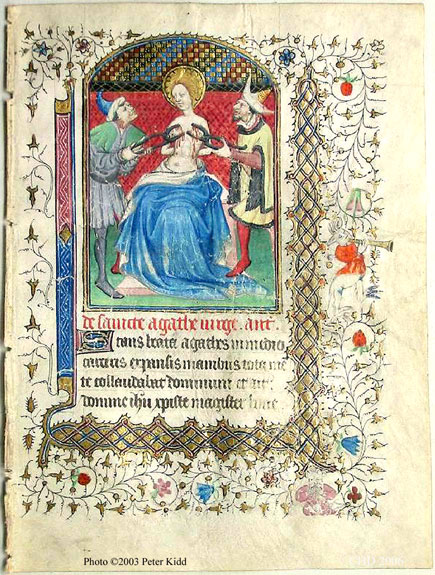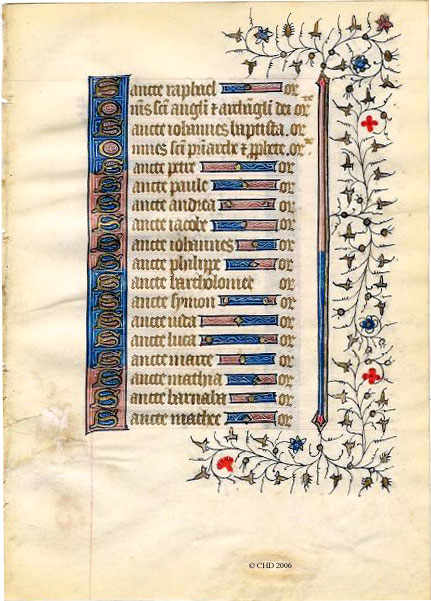
So-called "Sotheby's Hours" (Rouen c.1430-1432)
Heures à l'usage de Beauvais (Heures de Pierre Cauchon?)
 |
Dismembered Manuscripts 2002-2006 So-called "Sotheby's Hours" (Rouen c.1430-1432) Heures à l'usage de Beauvais (Heures de Pierre Cauchon?) |
 |  |
| f.87 St. Agatha having her breasts cut off by two men Miniature by the "Raoul d'Ailly Master" Collection of Margot and David Nishimura |
f.119 Page from the Litany with line-fillers and typical ivyleaf border See Contents for the Saints listed CHD Research Collection |
Collation as it was supposed in the Sotheby's catalogue from 1981, before any foliation in pencil was present:
i12, ii4, iii8, iv8+1, v-vii8, viii1+8, ix-x8, xi6, xii-xiv8, xv2+1, xvi-xvii8, xviii10, xix8, xx6, xxi-xxiii8, xxiv-xxv6, xxvi8+1, xxvii8+3, xxviii8+1, xxix6, xxx4, xxxi8+2, with two catchwords only.
Neigther the collation, nor the folio numbers of the miniatures is accurate, as has been proven by the fragments and their foliation as they turned up on the market.
Folio 69-70 is a bifolium with remains of the thread, which place it in the middle of a quaternion, and not at the end as in the attempted collation. Nor is the sequence of the various texts clear, as the catalogue from 1981 in some cases not seems to be consequent. The manuscript was not seriously misbound in 1981, but the position of the Pentecost and the Hours of the Cross as next to each other is impossible and indicate together with some other minor errors that the cataloguer at Sotheby's not established the exact foliation.
A new modern foliation in pencil in the lower right corner was probably written by a later owner after three or four miniatures already had been removed, the disagreement between the collation and the present foliation is increasing with the number of pages after the Hours of the Virgin, and explains how a textleaf could be numbered 86, same number a miniature was given in 1981.
Provenance:
Sold Sotheby's 9 February 1948 Lot 225 (Property of Oswald J. Swinburne);
Sold Sotheby's 14 July 1981 Lot 118 (The property of Mrs. A Manning), Catalogue p.53-54 with illustrations; Bought by the dealer Von der Merekt. Photographs from that sale now in the Conway Library at the Courtauld Institute (37 negatives, including all calendar pages).
Unaccounted for between 1981 and 2002 when large parts were dispersed by E. Neumann-Walter of Leipzig, and sold at various auctions as gatherings, miniatures and single leaves, the leaves mostly by way of eBay auctions (2002-2006).
Three miniatures sold by Christie's in Nov. 2002 (acquired by Maggs Bros., see Catalogue 1340 next).
Miniatures and a few well preserved single leaves sold by Maggs Bros. Ltd. (Illuminations. Catalogue 1340, 2003, No.9, 10, 11, 12, 13).
Gathering from the Office of the Dead, and two large miniatures sold by Sotheby's 17 June 2003 (Lots 58, 60, 61, last two acquired by Maggs Bros.).
Additional information about some of the multiple transactions, courteously provided by Paul Harcourt of Maggs Bros.:
Firstly, the miniature of St. Agatha was sold at Bonham's in London on 25/6/03, lot 337, catalogued as France, c. 1440 (acquired by Sam Fogg, photos by Peter Kidd 2003, now Margot and David Nishimura Collection).
Also Reiss & Sohn Auktion 86 (15-18 Oct. 2002), lots 1051-1054 had I think 14 text leaves and a miniature of the Nativity. The miniature may have been unsold since it appears to have been at Hartung's Auktion 13-15 May, 2003, lot 37. Lot 38 in the sale was a miniature of St. Maur [later resold on eBay by James Barrett], and lot 39 consisted of 4 text leaves. Also Reiss Auktion 89, 6-10 May, 2003, lot 1236 was a miniature of St. Aegidius from this manuscript, and 1237 consisted of 4 text leaves.
Bibliography:
Catalogue of Western Medieval and later Manuscripts, Sale Tuesday, 14th July, 1981, lot 118 (p.53-54, +ills.)
Sotheby Parke Bernet & Co., London 1981.
Susie Nash: Between France and Flanders. Manuscript illumination in Amiens in the Fifteenth Century. The British Library and University of Toronto Press, 1999, p.323-326 Catalogue *17 'Sotheby's Hours', (Figs.111, 112, 114, 115, 116).